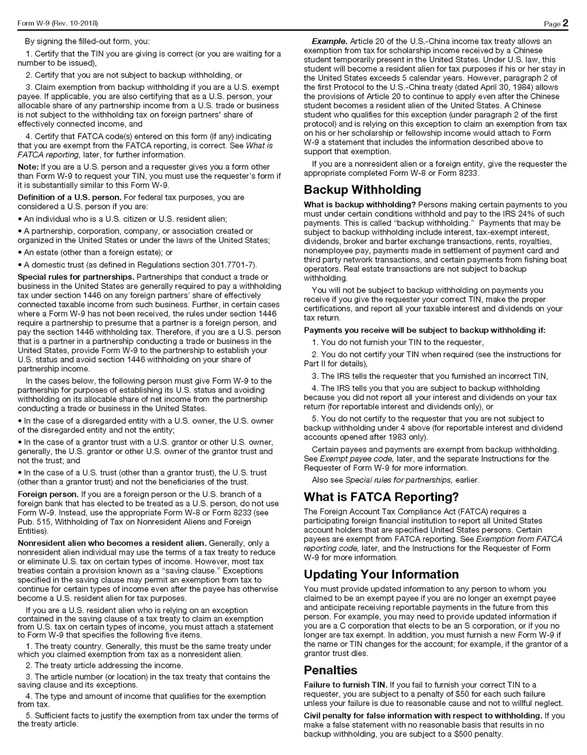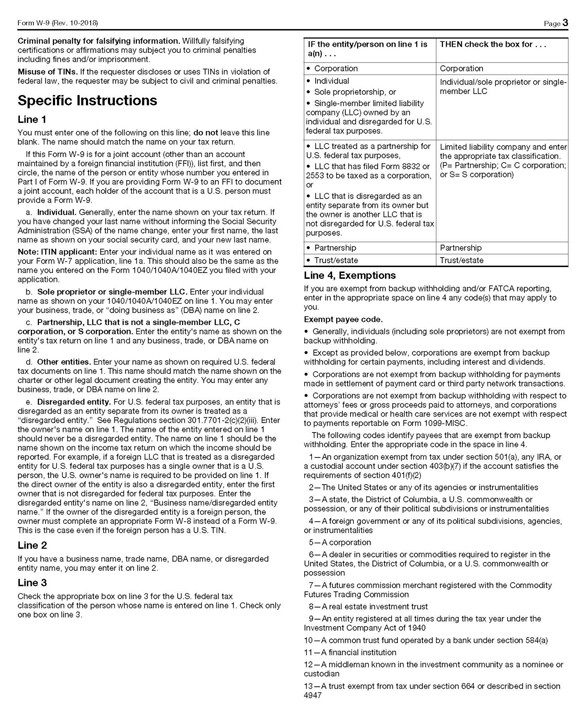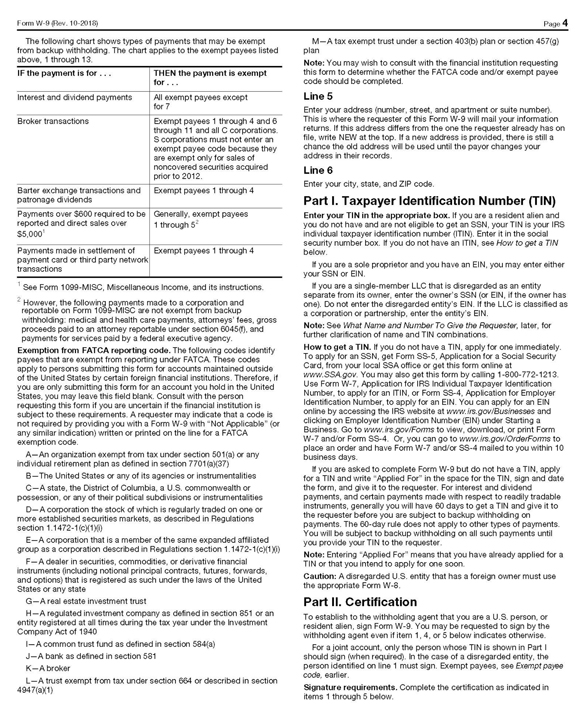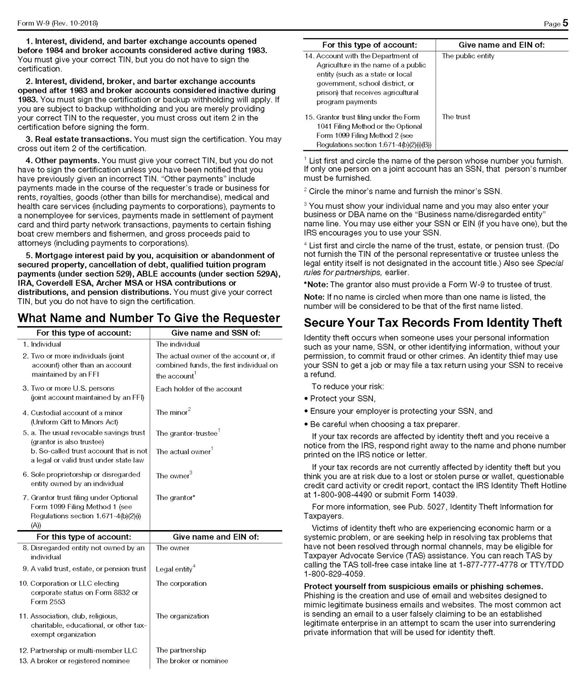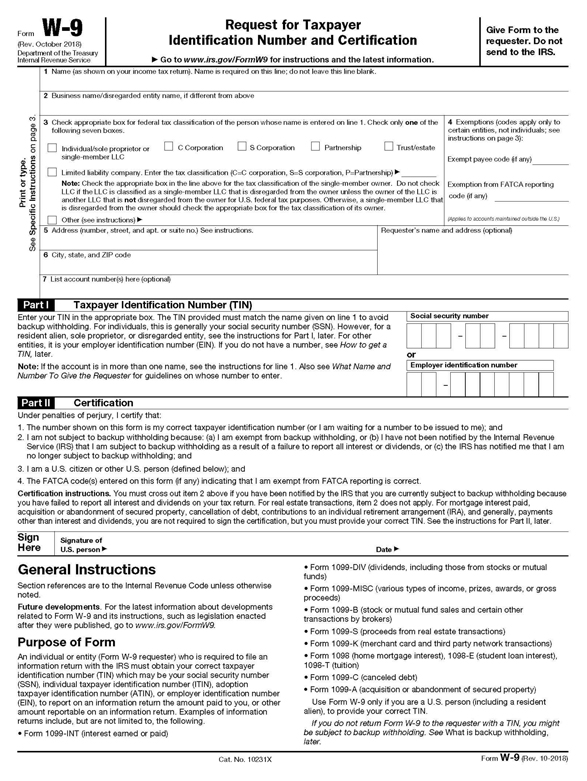
form W-9 (Rev. October 2018) Department of the Treasury Internet Revenue Service Request for Taxpayer Identification Number and Certification â–º Go to www.irs.gov/FonnW9 for instructions and the latest information. Give Form to the requester. Do not send to the IRS. . ns on page 3 1 Name (as shown on your income tax return). Name is required on this line; do not leave this tone blank. 2 Business name/disregardod entity name, if different from above 3 Check appropriate box tor federal tax classification of the person whoso name is entered on lino 1. Chock only one of the following seven boxes. 4 Exemptions (codes apply only to certain entities, not individuals; see instructions on page 3): Individual/sofe proprietor or C Corporation Corporation Partnership Trust/estate single-member LLC Exempt payee code $† any) Print or typ See Specific Instruction Limited liability company- Enter the tax classification (C=C corporation. S=S corporation. P=Partncrship) â–º Note: Check the appropriate box in the line above for the tax classification of the single-member owner. Do not check LLC if the LLC is classified as a single member LLC that is disregarded from the owner unless the owner of the LLC is another LLC that is not disregarded from the owner tor U.S. federal tax purposes. Otherwise, a single-member LLC that is disregarded from the owner should check the appropriate box for the tax classification of its owner. Exemption from EATCA reporting code (if any) Other (see instructions) â–º to accounts the U.SJ 5 Address (number, street, and apt. or suite no.) See instructions. Requester’s name and address (optional) 6 City, state, and 7IP code 7 List account number(s) here (optional) Taxpayer Identification Number (TIN) Enter your TIN in the appropriate box. The TIN provided must match the name given on line 1 to avoid backup withholding. For individuals, this is generally your social security number (SSN). However, for a resident alien, sole proprietor, or disregarded entity, see the instructions for Part I. later For other entities, it is your employer identification number (EIN). If you do not have a number, see How to get a TIN, later. Note: If the account is in more than one name, see the instructions for line 1. Also see What Name and Number To Give the Requester for guidelines on whose number to enter. Social security number or Employer identification number Certification Under penalties of perjury. I certify that: The number shown on this form is my correct taxpayer identification number (or I am waiting for a number to be issued to me); and I am not subject to backup withholding because: (a) I am exempt from backup withholding, or (b) I have not been notified by the Internal Revenue Service (IRS) that I am subject to backup withholding as a result of a failure to report all interest or dividends, or (c) the IRS has notified me that I am no longer subject to backup withholding; and I am a U.S. citizen or other U.S. person (defined below); and 4 The FATCA code(s) entered on this form (if any) indicating that I am exempt from FATCA reporting is correct. Certification instructions. You must cross out item 2 above if you have been notified by the IRS that you are currently subject to backup withholding because you have failed to report all interest and dividends on your tax return. For real estate transactions, item 2 does not apply. For mortgage interest paid, acquisition or abandonment of secured property, cancellation of debt, contributions to an individual retirement arrangement (IRA), and generally, payments other than interest and dividends, you are not required to sign the certification, but you must provide your correct TIN See the instructions for Part II. later. Sign Here Signature of U.S. person â–º Date â–º General Instructions Section references are to the Internal Revenue Code unless otherwise noted. Future developments For the latest information about developments related to Form W-9 and its instructions, such as legislation enacted after they were published, go to www.irs.gov/FormW9. Purpose of Form An individual or entity (Form W-9 requester) who is required to file an information return with the IRS must obtain your correct taxpayer identification number (TIN) which may be your social security number (SSN), individual taxpayer identification number (ITIN), adoption taxpayer identification number (ATIN), or employer identification number (EIN), to report on an information return the amount paid to you, or other amount reportable on an information return. Examples of information returns include, but are not limited to, the following. • Form 1099-INT (interest earned or paid) Form 1099-DIV (dividends, including those from stocks or mutual funds) Form 1099-MISC (various types of income, prizes, awards, or gross proceeds) Form 1099-B (stock or mutual fund sales and certain other transactions by brokers) Form 1099-S (proceeds from real estate transactions) Form 1099-K (merchant card and third party network transactions) Form 1098 (home mortgage interest), 1098-E (student loan interest), 1098-T (tuition) Form 1099-C (canceled debt) Form 1099-A (acquisition or abandonment of secured property) Use Form W-9 only if you are a U.S. person (including a resident alien), to provide your correct TIN. If you do not return Form W-9 to the requester with a TIN, you might be subject to backup withholding. See What is backup withholding, later. Cat. No. 10231X Form W-9 (Rev. 10-2018)
12
